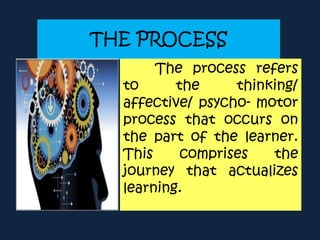Lesson 7
- 1. Lesson 7 IT for Higher Thinking Skills and Creativity
- 2. The old or traditional methods of teaching makes use of audio-visual aids or devices, chalk and black board for illustrations. Magazines and books for references, which are always provided by the teacher.
- 3. In the new era of modern technology, students are encouraged to develop their own ideas and ways on how to gather information needed for their subjects in school. Their creativity is developed and intellectual independence is nurtured when they are given the leeway to produce projects and reports using the software of the computer.
- 4. THINKING SKILLS FRAMEWORK Complex Thinking Skills Sub-skills Focusing Defining the problem, goal/objective- setting, brainstorming Information gathering Selection, recording of data of information Remembering Associating, relating new data with old Analyzing Identifying idea constructs, patterns Generating Deducing, inducting, elaborating Organizing Classifying, relating Imagining Visualizing, predicting Designing Planning, formulating Integration Summarizing, abstracting Evaluating Setting criteria, testing idea, verifying outcomes, revising
- 5. This framework shows the teacher’s effort to understand the learner’s higher thinking skills. Given those complex thinking skills, the modern day teacher can now be guided on his goal to help student achieve higher level thinking skills and creativity beyond the ordinary benchmark of the student’s passing, even excelling achievement tests.
- 6. The Upgraded Project Method Given these complex thinking skills, the modern day teacher can now be guided on his goal to help student achieve higher level thinking skills and creativity beyond the ordinary benchmark of the student’s passing, even excelling achievements tests.
- 7. Project method is an example of higher learning outcomes because the students work on projects with strength, involvedness, length and relevance to the real world.
- 8. THE PROCESS The process refers to the thinking/ affective/ psycho- motor process that occurs on the part of the learner. This comprises the journey that actualizes learning.
- 9. To understand this lesson better, the following IT-based projects are given: 1. Resource-based projects – the teacher steps out of the traditional role of being a content expert and information provider. The students are required to use the available textbooks and curriculum materials. 2. Simple Creation – the students are assigned to create their software materials to supplement the need for relevant and effective materials.
- 10. 3. Guided hyper-media projects – this project can be used in two different ways like instructive tool and communication tool. Instructive tool is used during lecture or discussion like power-point presentation while communication tool is used when the students do a multimedia presentation (with text, graphs, photos, audio and etc.). 4. Web-based projects – students can be made to create and post WebPages on a given topic.









